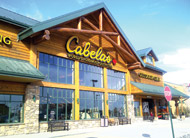|
CITY HIGHLIGHT, JULY 2012
LOUISVILLE
Louisville Industrial Market
 |
Hartlage |
|
Louisville’s Class A industrial market has continued its strong performance through the first two quarters of 2012. Robust transaction velocity in 2011 led to net absorption of more than 2.2 million square feet and a sub-8 percent vacancy rate for the first time since 2008. Louisville’s bulk market weathered the economic downturn well and delivered five straight years of positive net absorption. We anticipate this streak extending.
In addition to leasing activity, capital markets have re-emerged as a driver of deal volume. Similar to most markets, Louisville’s investment activity was nonexistent from late 2008 to late 2010, but rebounded in 2011 and continues to surge in 2012. Confidence in Louisville’s bulk market led to two new landlords entering the market: STAG Industrial and International Airport Centers purchased four buildings totaling more than 1 million square feet.
During the last 12 months, existing landlords have confirmed their commitment in Louisville by increasing market share as well. After selling 526,000 square feet in December 2010, Exeter Property Group re-established its Louisville presence by acquiring seven buildings totaling more than 1.7 million square feet. Additionally, KTR Capital Partners purchased two facilities totaling more than 962,000 square feet and ING Clarion recently purchased a 303,000-square-foot building. We anticipate one or two additional investment sales by the end of the year. The appetite for product exceeds this number, but the number of assets that traded during the last five years limits the availability of suitable Class A institutional options.
While organic growth in the e-commerce and pharmaceutical sectors fueled a significant amount of activity during the last 18 months, new manufacturing and light assembly operations contribute to Louisville’s strong numbers as well. The ability of landlords to secure lease renewals played a significant factor in the continued stability of Louisville’s Class A market during the last three years. Major tenants such as Zappos.com, GSI Commerce, Guess, Brightpoint, MasterBrand and aNETorder reaffirmed their commitment to the market with recent renewals.
There are pockets of space where Louisville is beginning to experience a shift in dynamics from a tenant-driven market to one where landlord leverage is increasing. At present, our market offers three availabilities larger than 300,000 square feet. However, if one or two active prospects in the market execute transactions, the likelihood that first speculative construction in three years could commence by the fourth quarter increases. At present, the largest construction project underway is KTR Capital Partners’ 1 million-square-foot build-to-suit facility for Amazon.com in the Southern Indiana submarket.
Given the overall market dynamics, we remain optimistic that Louisville will continue to thrive as an industrial market and maintain a favorable position among investors and operators.
— Matt Hartlage, SIOR, is an industrial properties specialist with Louisville-based Cassidy Turley Harry K. Moore.
Louisville Retail Market
 |
Bellis |
|
The Louisville retail market is showing signs of stabilization and moderate signs of new growth. The retail landscape has significantly improved with the addition of desirable retailers such as Trader Joe’s, Anthropologie, Urban Outfitters and Cabela’s. All are open or under construction in Louisville, with other sought-after retailers considering the city as well.
Retail activity has been widespread, but more extensive in Louisville’s east end. General Growth Properties has continued to attract tenants such as Anthropologie by providing exterior facades and entrances at Mall St. Matthews and Oxmoor Mall. A Cinemark theater is under construction in a former Dillard’s store at Mall St. Matthews.
 |
Cabela’s will open its first Kentucky store at Old Brownsboro Crossings in the spring of 2013. |
|
After stalling during the recession, Louisville’s northeast side continues to be the growth pocket it was prior to the downturn, and with road improvements nearing completion, signs of life are returning to the area. Several new retailers have been added to the tenant mix at The Summit, Louisville’s lifestyle center, including a 25,000-square-foot Earth Fare, an organic grocery store set to open in the fall. Old Brownsboro Crossings, a retail and medical center anchored by Costco, Lowe’s and Norton Hospital, recently signed an 88,000-square-foot lease with Cabela’s for a store that is scheduled to open in the spring of 2013. This will be the first Cabela’s in the state.
The 812,000-square-foot Springhurst Towne Center, a power center anchored by Meijer, Target, Dick’s Sporting Goods and a Cinemark theater, recently sold to the California State Teachers Retirement System for $78 million.
Downtown Louisville has seen a renaissance during the last year due to the opening of the $350 million Yum! Center arena. The arena is home to the University of Louisville Basketball Team and host to numerous concerts. Many entertainment venues have opened near the arena capitalizing on its success. The redevelopment of Louisville’s downtown waterfront is nearing completion with the final phase of the development, a pedestrian bridge connecting downtown Louisville with southern Indiana set to open in the spring of 2013. In addition, Louisville has worked through the issues surrounding its $2.5 billion dollar Ohio River bridge projects, which will add a new downtown and east end bridge connecting Louisville and southern Indiana.
While new ground-up retail development in Louisville is mirroring that of the national scene and not likely to improve near-term, redevelopment of existing retail centers is key to the health of Louisville’s retail environment. Anchor and junior anchor boxes are being back-filled, but small shop retailers still seem to be struggling and absorption continues to be a problem.
Louisville’s diverse economy and slow to moderate growth prior to the downturn seem to have helped the city avoid the worst of the recession and aid recovery. While manufacturing was the primary driver of the Louisville economy in the 1950s and is still a significant contributor today, the economy is much more diverse with increases in other fields, including healthcare, food service, distilled spirits and distribution. Louisville’s largest employers include UPS, whose air hub is in the city; Ford; General Electric; Humana; Norton Healthcare; YUM! Brands, which owns KFC, Pizza Hut and Taco Bell; Amazon; and Brown-Forman, which makes Jack Daniels.
We anticipate retailers will continue to adapt to the many changes and challenges facing the retail industry today, including downsizing of existing stores and relocation of others. Retail continues to be an ever-changing industry. With a diverse economy, bridge projects under way, a new downtown arena and several new hot retailers, Louisville has the momentum for a prosperous retail future.
— Frank Bellis is a partner with Louisville-based TRIO Commercial Property Group.
Louisville Multifamily Market
 |
Johnson |
|
Limited multifamily rental development and additional hiring by local employers will sustain another strong year for the Louisville apartment sector during 2012. Despite a slight increase in vacancy during the first three months of the year, tight conditions prevail as many residents moved into apartments during the past two years.
Local employers expanded payrolls during the past two years and more than half of the jobs lost in the metro during the recession have been recovered. The market continues to benefit from the revival of Ford, while the area’s logistics and transportation employers have added workers as more packages and freight move through Louisville en route to other markets.
The reinvigorated drivers of apartment demand continue to benefit most locations around the metro, but none more than the submarkets encompassing suburban communities located beyond the inner beltway. Overall vacancy in this area, which contains about three-fourths of the market’s apartments, sits at less than 4 percent, with the Class A rate closer to 3 percent.
A lack of new construction will keep rents and vacancies healthy in the Louisville metro area. The 35-unit Whiskey Row Lofts in the West Central submarket delivered in the first quarter, becoming the only market-rate rental project to come on line in the past year. An additional 600 apartments are under way in the metro. Only the 150-unit River Breeze has a firm delivery date, with the project slated for completion in the third quarter. Also, 242 units at Claibourne Crossings in the Northeast Jefferson County submarket are slated to break ground in the third quarter.
Renter demand eased in the first quarter, resulting in a 10-basis point uptick in vacancy to 4.5 percent. Vacancy has nonetheless decreased 80 basis points during the past year and sits at one of the lowest levels recorded during the past 10 years. Asking rents rose 0.9 percent from January to March to $667 per month, while effective rents advanced 1.1 percent to $638 per month. Year over year, asking and effective rents advanced 2.8 percent and 3.2 percent, respectively, trimming concessions to 4.3 percent of asking rents.
The strong performance of the apartment sector continues to heighten interest in local properties. Listings of Class A or Class B assets typically generate multiple offers, and cap rates in recently closed deals range from 6 percent to 7 percent. However, few Class A complexes have been built during the past 10 years, and investors are increasingly looking for Class B assets in strong areas. The higher cap rates in recent deals here reflect the metro’s older stock, not newer offerings.
Interest in smaller properties also started to show new life recently, though many owners appear hesitant to list while property operations are strengthening. Nonetheless, the apartment sector’s improved performance during the past year has firmed values, and many well-located assets will attract considerable attention when listed. Interest in distressed properties with either near-term debt maturities or deferred maintenance persists, though competitive bidding continues to push up pricing. These assets are typically purchased on a price-per-unit basis, and many buyers look to later resell the property at exit cap rates ranging from 9 percent to 10 percent.
— Aaron Johnson is a vice president of investments in the Louisville office of Marcus & Millichap.
Louisville Office Market
 |
Scherer |
|
Southern by tradition but Midwestern by culture, Louisville is undergoing a renaissance of sorts with significant employment gains in manufacturing, education and healthcare which, collectively, have lowered the metro unemployment level below 9 percent and well within reach of the national unemployment rate.
Ford Motor Company’s $1.2 billion investment at the Louisville Assembly Plant and the Kentucky Truck Plant will provide significant job gains in manufacturing; and General Electric’s continued investment at Louisville’s Appliance Park will contribute additional manufacturing job gains. This improvement in the local economy should begin to translate into positive real estate fundamentals for the office sector.
Louisville has no shortage of available space with an overall vacancy rate in the office market of 14.1 percent. However, large blocks of Class A suburban space are quickly disappearing which may encourage speculative construction starts later this year.
The Central Business District has seen no new office building completions recently, and the suburban market has only seen 125,000 square feet completed. The pre-leasing success of the 125,000-square-foot 600 North building, located on the Shelby Campus of the University of Louisville, surprised even some seasoned developers. While the overall suburban vacancy rate increased during the first quarter from 16.8 percent to 17.3 percent, the Class A suburban vacancy rate increased nominally from 14.5 percent to 14.8 percent. With no further construction completions expected for the balance of 2012, vacancy rates should fall as absorption improves during the second half of the year, particularly in the Class A market which experienced 158,000 square feet of the 215,000 square feet of leasing activity during the first quarter of the year.
The CBD market experienced 161,146 square feet of leasing activity during the first quarter, which translated into 120,671 square feet of positive net absorption, somewhat evenly split between Class A and Class B space. As a result, the overall CBD vacancy rate declined from 12 percent to 10.3 percent while the Class A vacancy rate declined from 7.3 percent to 5.8 percent.
Unfortunately, some of the absorption enjoyed during the first half of the year will likely be offset by the considerable inventory of available space coming back to the market during the second half of the year as a result of corporate downsizing by Aegon USA and Mercer. As a result there may be as much as 240,000 square feet of available Class A space in the Meidinger and Brown & Williamson Towers, which anchor Fourth Street Live!, Louisville’s destination entertainment attraction in the heart of downtown.
On the plus side, Louisville can offer large blocks of Class A space at asking rates around $17.50 per square foot on a gross, full-service basis. Adding to Louisville’s appeal is its reputation for lower cost of living and lower cost of doing business than many of its competing cities in the Midwest. According to the Council for Community and Economic Research (C2ER), Louisville’s overall cost of living is about 11 percent below an average of 306 cities included in C2ER’s Cost of Living Index. Housing costs remain a real bargain at 22.5 percent cheaper in Louisville than nationally and Moody’s Analytics pegs Louisville’s cost of doing business at 81 percent of the U.S. average.
Indeed, the future looks bright for Louisville.
— E.P. Scherer IV is senior office advisor at Commercial Kentucky, a member of the Cushman & Wakefield Alliance.
©2012 France Publications, Inc. Duplication
or reproduction of this article not permitted without authorization
from France Publications, Inc. For information on reprints
of this article contact Barbara
Sherer at (630) 554-6054.
|
